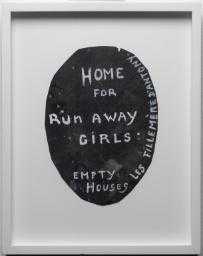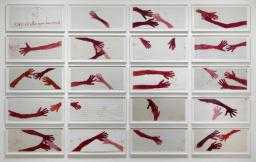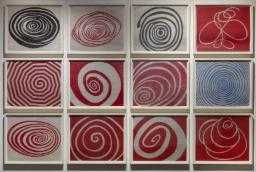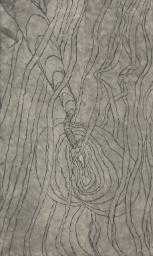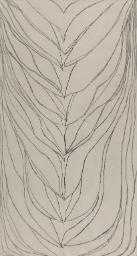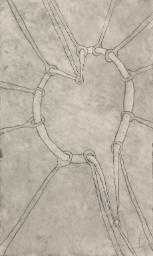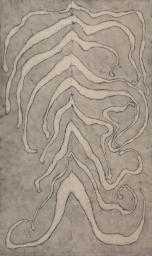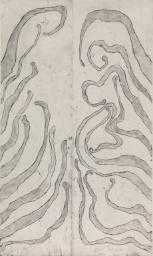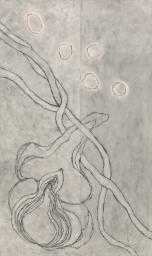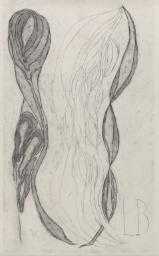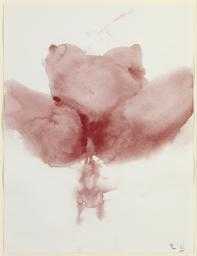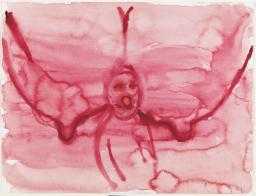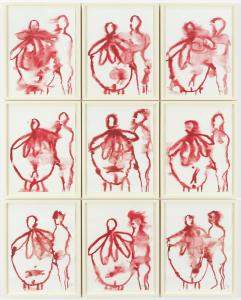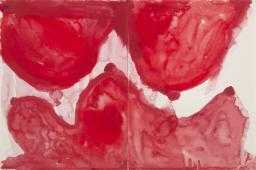
Not on display
- Artist
- Louise Bourgeois 1911–2010
- Medium
- Gouache on paper
- Dimensions
- Frame: 680 × 543 × 40 mm
image: 597 × 457 mm - Collection
- ARTIST ROOMS
Tate and National Galleries of Scotland. Lent by the Tate Americas Foundation for the Tate Gallery, courtesy of The Easton Foundation 2013
On long term loan - Reference
- AL00348
Summary
Femme 2007 is a work in red gouache on paper that depicts an ostensibly female form. The figure is portrayed in outline only, her body visible down to the knee, with the lower legs and feet not pictured. The shape of her breasts, navel, vulva and upper thighs are each picked out in single brushstrokes. Her face has no features and her arms are obscured by brushstrokes emanating from the top of the head and continuing to the base of the painting, depicting the figure’s hair. The paint appears smudged in some areas, potentially where it has been mixed with water, reducing the vivid red of the gouache to shades of pink. The artist has included her initials (‘LB’) in black at the bottom right corner of the painting.
Bourgeois’s use of the colour red is a recurring characteristic of her artistic practice. The artist employed the colour often in her work in order to refer to the extremes of human emotion. In a statement first published in 1992, Bourgeois said: ‘Red is an affirmation at any cost – regardless of the dangers in fighting – of contradiction, of aggression. It’s symbolic of the intensity of the emotions involved.’ (Quoted in Askew and d’Offay 2013, p.85.) She went into more detail regarding her thoughts on the multiple connotations of the colour when she wrote:
Red is the colour of blood.
Red is the colour of paint.
Red is the colour of violence.
Red is the colour of danger.
Red is the colour of shame.
Red is the colour of jealousy.
Red is the colour of grudges.
Red is the colour of blame.
(Quoted in Morris 2007, p.83.)
The colour red also appears in Bourgeois’s other works on paper such as À L’Infini 2008–9 (Tate AL00357) and 10 am is When You Come to Me 2006 (Tate AL00345), where it is again used to represent the extremes of human emotion. In Femme the colour may signify the sexuality of the female figure, the warmth of the human body or the blood that can be present at both birth and death.
The title of the work suggests that the figure is representative of womankind in general, which may explain why her face is without features that would make her recognisable. She is also reminiscent of the female figure in Bourgeois’s Nature Study 1986 (Tate AL00228), who has little definition in her facial features and has long hair that ultimately forms the spiral from which a hand emerges to support her in a depiction of the cycle of motherhood, birth and rebirth. The figures in both Nature Study and Femme appear to have no arms, suggesting a degree of vulnerability. Again, this contrasting depiction of strength, sexuality and vulnerability may be intended to represent all women as opposed to an individual female.
Further reading
Mignon Nixon, Fantastic Reality: Louise Bourgeois and a Story of Modern Art, Cambridge, Massachusetts and London 2005.
Frances Morris (ed.), Louise Bourgeois, exhibition catalogue, Tate Modern, London 2007.
Lucy Askew and Anthony d’Offay, Louise Bourgeois: A Woman Without Secrets, exhibition catalogue, National Galleries of Scotland, Edinburgh 2013, reproduced p.63.
Allan Madden
The University of Edinburgh
December 2015
The University of Edinburgh is a research partner of ARTIST ROOMS.
Does this text contain inaccurate information or language that you feel we should improve or change? We would like to hear from you.
You might like
-
Louise Bourgeois Home for Runaway Girls
1994 -
Louise Bourgeois 10 am is When You Come to Me
2006 -
Louise Bourgeois Spirals
2005 -
Louise Bourgeois À L’Infini
2008–9 -
Louise Bourgeois The Nest
2009 -
Louise Bourgeois The Smell of Eucalyptus (#2)
2006 -
Louise Bourgeois The Stretch
2006 -
Louise Bourgeois Are You In Orbit? (#1)
2007 -
Louise Bourgeois Are You In Orbit? (#2)
2007 -
Louise Bourgeois Love and Kisses
2007 -
Louise Bourgeois The Unfolding
2007 -
Louise Bourgeois The Birth
2007 -
Louise Bourgeois The Feeding
2007 -
Louise Bourgeois The Family
2008 -
Louise Bourgeois The Friendly Landscape
2008

